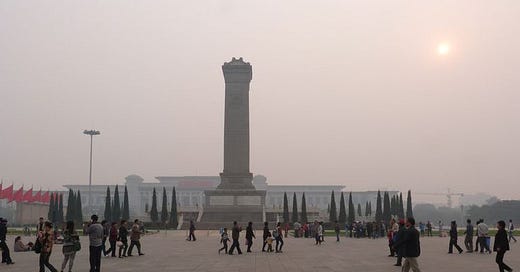From the archives: Study Shows That Climate Change Is Really Bad for Your Health
Along with climate-killing CO2, there are a lot of people-killing pollutants. Perhaps we should change our message.
As wildfire smoke settles over Southern Ontario, I am going through my archives and looking for posts I have written about particulate pollution, which were deleted from Treehugger since I am an architect, not a doctor, so what do I know about health? I am reconstructing them and posting them here. This one is from December 2018.
It is really hard to get people to care about climate change. A Gallup poll earlier this year found that less than half of Americans believe it will affect them personally: "57% of Republicans think it will not happen in their lifetime (25%) or will 'never happen' (32%)."
Perhaps more would care if they realized that it was killing them at worst, and shortening their lives at minimum. According to a report from the World Health Organization released at COP24, there is a direct correlation between the climate change and health.
Of course, there are many who deny that Carbon Dioxide should be classed as a pollutant, but all those fossil fuel eating machines that spew it out also put out particulates and other pollutants that are affecting us personally right now. Perhaps we are delivering the wrong message. Diarmid Campbell-Lendrum of WHO says, "We should no longer be talking about the cost of [cutting emissions], we should talk about the benefits to people’s health of investing in what needs to be done."

The drivers of climate change – principally fossil fuel combustion – pose a heavy burden of disease, including a major contribution to the 7 million deaths from outdoor and indoor air pollution annually. The air pollutants which are causing ill-health, and the greenhouse gases (GHGs) that are causing climate change, are emitted from many of the same sectors, including energy, housing, transport and agriculture. Short-lived climate pollutants (including black carbon, methane and ozone) have important impacts on both climate and health.
Maria Neira, the WHO director of public and environmental health, isquoted in the Guardian:
“If you don’t think you need to take action for the sake of climate change, make sure when you think about the planet you incorporate a couple of lungs, a brain and a heart. It is not just about saving the planet in the future, it is about protecting the health of the people right now.”

Twenty-five percent of fine particulate matter pollution comes from traffic, 15 percent from industry, 20 percent from fuel burning and 22 percent from "unspecified sources of human origin" like Montreal bagels and wood-fired pizza.
A warming climate will worsen air quality. If current emissions continue, ground-level ozone events are expected to intensify, especially in densely populated areas, leading to more respiratory illness. In certain areas, the frequency and extent of wildfires – and with them, emissions of particulate matter and other pollutants – are projected to increase.
Perhaps this will move the needle for people who do not believe in climate change. Perhaps when they realize how harmful these pollutants are, they will stop buying heavy SUVs, building houses in wildfire country, or burning coal. Or perhaps they will just put on yellow vests, protest against carbon taxes, and pretend none of this matters.




What will the worl do about China building a new coal plant every week? Or, India's lack of environmental control? Billions of people in each country, yet the burden is on the western world. Consider wild fires. What are environmental groups doing about that. It's just like nuclear power, in the 80s, nuclear power bad. Now, nuclear power good. The industry was decimated. Now everyone wants it up and running tomorrow. A construction permit takes at least 2 years in the US. As far as forest fires go, natural is good. No clean up no controlled burns, now huge fires. I grow up in Northern California where controlled burns were a normal thing. Fires still happened but they were controlled. The fire in Palisades was totally predictable and preventable. There was a fire in the 60s in a Brentwood, it was bad but controlled. Lessons learned were forgotten. How could 60s technology be better than 2025? Don't weigh all of these supposed improvements on the western world. Who has been benefiting from the climate change situation? Solar and wind? China. It's so obvious. While the US goes to a part time unreliable energy source that China sells to the world which shuts down reliable sources, China keeps building coal plants and polluted the world. It's nice to thonk about saving the world, but everybody needs to be involved.
Here’s the problem: Whereas air pollution isn’t controversial enough on its own, climate change and global warming are. That said, I own one book covering both global warming and air pollution, which is why I bought it. The other book I own on world conditions that affect its well-being, has 3 chapters covering global warming.
Meanwhile, there is interesting research that was conducted by a team at the University of California, Berkeley, which found a correlation between the incidence of tule fog in the Golden State and airborne concentrations of ammonium nitrate, which forms in the atmosphere during times of cold weather from oxides of nitrogen - NOx (released from transportation and other sources) and ammonia (produced from dairies mainly). As the California air has become cleaner with lower NOx levels being introduced into the air, the incidence of tule fog in state, and particularly that which is present in the San Joaquin Valley, the episodes of thick, dense tule fog has also become fewer and farther between. You can read about it here: “Falling levels of air pollution drove decline in California’s tule fog,” an April 10, 2019 university news release. Representative URL: https://news.berkeley.edu/2019/04/10/falling-levels-of-air-pollution-drove-decline-in-californias-tule-fog/